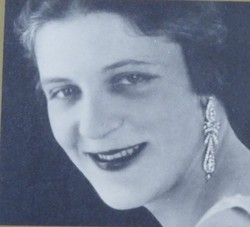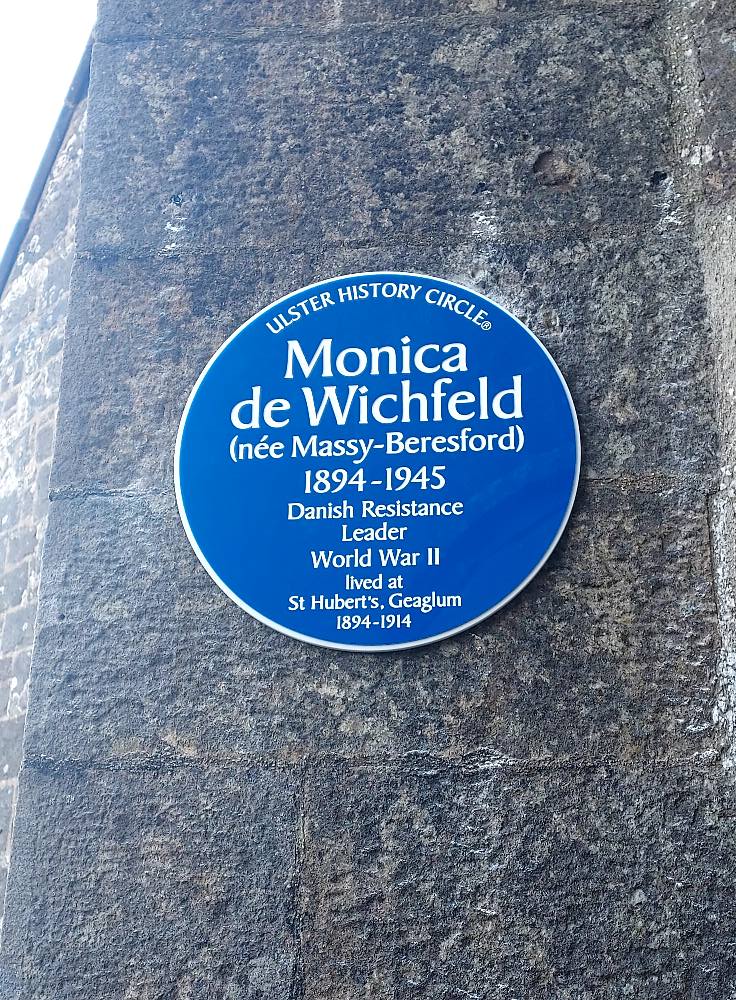"Heid" [Heed] Meaning: Head
Blue Plaque - Monica De Wichfeld

11 November 2023
A blue plaque has been unveiled to commemorate Monica de Wichfeld, a World War II Danish Resistance Leader.
Monica Massy-Beresford was born on 12th July 1894 at 7 Eaton Square, London, the daughter of John George Massy-Beresford and the Honourable Alice Elizabeth Mulholland, the daughter of John Mulholland, the 1st Baron Dunleath of Ballywalter. The Massy-Beresford family came from Irish-Scottish stock. Ten days after her birth, Monica arrived at their Irish home, St, Hubert’s Geaglum, Derrylin and so began her early life in Co. Fermanagh.
Her childhood was spent in the large comfortable Victorian house which had been acquired by the Dean of Kilmore, her grandfather. Monica’s memories of her childhood were centred on St. Hubert’s and the lake. Lough Erne played a vital part in the lives of Monica and her three brothers. She tells of going to Church in a motorboat, being schooled by a governess, visiting the Brookes of Colebrook, her cousins the Crichtons of Crom and many other families who lived overlooking Upper Lough Erne. At an early age Monica became an excellent sailor and could be seen crewing for her father at the annual regatta at Crom Castle. Her father, an accomplished sportsman, held the position of the High Sheriff for Co. Fermanagh.
As a teenager Monica was sent to school in Dresden, Germany and travelled in Europe.
Her peaceful life at St. Hubert’s was shattered with the start of World War I. Her father left to join the Ambulance Corp and her brothers joined the regiment. She saw her cousins and friends killed early in the war.
In 1915 she left St. Hubert’s and obtained a job in a soldier’s canteen in the East End of London.
In 1916 Monica Massy-Beresford married Danish aristocrat and diplomat, Jorgen Wichfeld, the Secretary of the Danish Legation in London. She and Jorgen moved to his Engestofte Estate in Lolland, Denmark and Monica became a Danish citizen. Three children followed, Ivan, Varinka and Viggo.
The years that followed saw Monica de Wichfeld travel widely in Europe and socialise with notable people as Noel Coward, Clementine Churchill and many other household names. She also developed a line of beauty products with Coco Chanel. Monica’s glamorous and fashionable life was an unusual preparation for her heroic wartime role.
 In 1941, Monica, Jorgen and family were living on the estate at Engestofte in occupied Denmark. Without her husband’s knowledge, she became an active member of the underground Danish resistance. During the years until January 1944, when her name was given to the Gestapo by one of her own comrades, Monica grew to lead the Lolland resistance and Engestofte became central to the recruitment, training, arming, planning, direction and organisation of the actions of the resistance. She was involved in harbouring RAF paratroopers and through the underground movement was able to have them returned to Britain. She and her group dealt with arms drops, explosives, she hid refugees and members of the Jewish community who were being sought by the Gestapo.
In 1941, Monica, Jorgen and family were living on the estate at Engestofte in occupied Denmark. Without her husband’s knowledge, she became an active member of the underground Danish resistance. During the years until January 1944, when her name was given to the Gestapo by one of her own comrades, Monica grew to lead the Lolland resistance and Engestofte became central to the recruitment, training, arming, planning, direction and organisation of the actions of the resistance. She was involved in harbouring RAF paratroopers and through the underground movement was able to have them returned to Britain. She and her group dealt with arms drops, explosives, she hid refugees and members of the Jewish community who were being sought by the Gestapo.
In 1944 she was arrested along with six other colleagues and tried before a Nazi court. All were found guilty and sentenced to death. In court, on hearing of the death sentence, she promptly brought out her powder and lipstick and coolly attended to her appearance. ‘Will that be all gentlemen’ she said. Her companions were shot but owing to the intervention of the Queen of Denmark who was a family friend, she was reprieved and her sentence commuted to life imprisonment.
Monica was a heavy smoker and she was deprived of her cigarettes but she was offered them if she would disclose information. Never did she disclose information during the long gruelling hours of interrogation. Whilst in prison she showed great courage and fortitude and was a ‛leader’ amongst the women she was with. She organised work among her fellow prisoners and her sense of humour never deserted her. Monica was moved from Denmark to Germany and finally to Waldheim Prison Concentration Camp. Her health deteriorated badly and after having tuberculosis, she died of pneumonia on 27th February 1945, one month before the end of the war and 13 months after her captivity. Her body was never found.
Chris Spurr, Chairman of the Ulster History Circle, comments: "Monica de Wichfeld spent her early life in Co. Fermanagh with her parents, the Massy-Beresfords, then after marriage she lived across the Continent in the inter-war years of the 1920s and ‘30s. It was in Denmark that she became a heroine of World War II, and on Armistice Day the Ulster History Circle is delighted to commemorate this leader of the Danish resistance with a blue plaque. The Circle is particularly grateful to the Ulster-Scots Agency for their financial support, and to the Rev. Alastair Donaldson, rector of the Kinawley and Holy Trinity group of parishes, for his valued assistance."
Monica's death had a profound effect and she was mourned by the public as well as her family and friends. There is a memorial to her in her beloved Engestofte Church in Denmark In Derrylin her name is in the Parish Church on the Roll of Honour of those who gave their lives in World War II.
Monica De Wichfeld (nee Massy-Beresford) 1894-1945
Danish Resistance Leader World War II
The unveiling of the plaque took place at Kinawley Parish Church, 146 Main Street, Derrylin, Co. Fermanagh BT92 9PD, and was unveiled by Lady Dunleath of Ballywalter, Co. Down.

